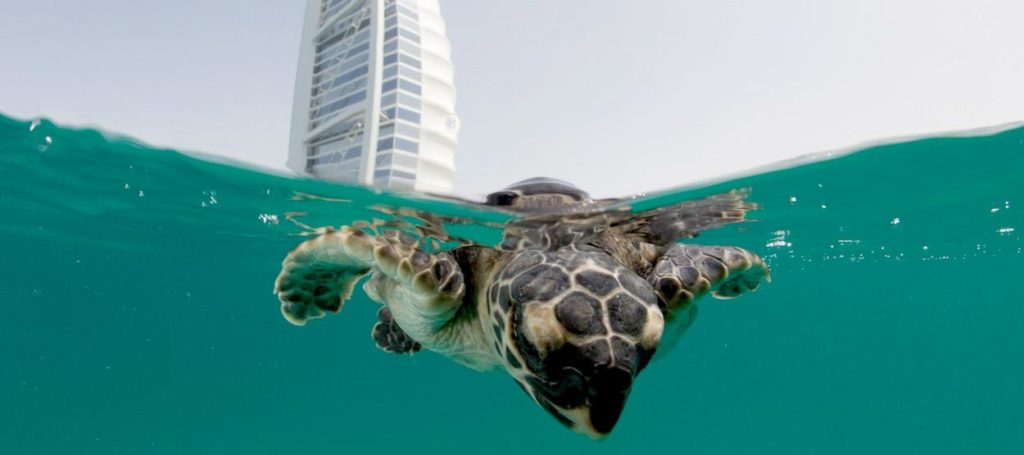The Dubai Turtle Rehabilitation Project (DTRP) has rehabilitated and returned 1,175 turtles into the Arabian Gulf since the project began in 2004. A rare olive ridley sea turtle called Barnacle checked out of Jumeirah Al Naseem’s turtle rehabilitation lagoon with more than 70 critically endangered hawksbill turtles who headed back home into the waters of the Arabian Gulf.
Children from the Dubai British School purchased a special satellite tag for Barnacle which will enable them to track her progress online here. The kids were invited to the release learn more about the Dubai Turtle Rehabilitation Project (DTRP) and wave the turtles off from the beach by Jumeirah Al Naseem.
Warren Baverstock, Burj Al Arab’s Aquarium Operations Manager, said: “There are very few olive ridleys nesting in Arabia and all of them nest on Masirah Island in Oman. This is the first time an Olive Ridley has been tagged in the UAE and we are all very excited to discover where she will travel to next. This initiative provides valuable data about how the turtles are progressing in the wild. We are especially gratefully to the local community and the organisations who found many of the injured turtles and brought them to us for rehabilitation.”
Barnacle was rescued several months ago and was suffering from positive buoyancy which meant the turtle was constantly floating high up in the water. After spending time in the turtle rehabilitation facilities at Burj Al Arab Jumeirah, the Dubai Turtle Rehabilitation Project (DTRP) team moved her into the turtle lagoon at Jumeirah Al Naseem and within three weeks she was able to swim down to the bottom.
This latest release brings the total number of turtles returned to the wild since the project began in 2004 to 1,175. All the turtles have been rescued from the shores of the UAE by members of the public and nursed back to health by the DTRP, one of the longest standing Corporate Social Responsibility initiatives in the region and the only project of its kind in the Middle East. All the turtles started their rehabilitation at the facilities within Burj Al Arab Jumeirah and then moved to the new turtle lagoon at Jumeirah Al Naseem prior to release.
The project accepts any distressed turtle, with the most common turtles found in the Arabian Gulf being the critically endangered hawksbill and the endangered green sea turtle. The majority are juvenile hawksbills, which are found washed up on the coast during the winter months of December, January and February suffering from the adverse effects of cold sea temperatures. Other common ailments include ingesting plastic rubbish and injuries sustained from boats.
Situated near the shores of the Arabian Gulf within landscaped gardens, the new facility at Jumeirah Al Naseem is the region’s first purpose-built lagoon for rehabilitating rescued turtles. The animals which have suffered a range of illnesses or traumas can be carefully monitored in the lagoon before they are returned back to their native waters. The new lagoon facility and nature trail is the public interface of the DTRP. The project plays a vital role in helping to raise awareness of the plight the turtles face.
The opening of the lagoon was a dream come true for marine biologist Warren Baverstock and his small team of six who work tirelessly to rescue and rehabilitate injured and sick turtles (mainly hawksbills, green and loggerheads) from around the region. It’s the combination of over 12 years of continuous hard work and their innate passion for wildlife which has enabled the project to get to this stage.


